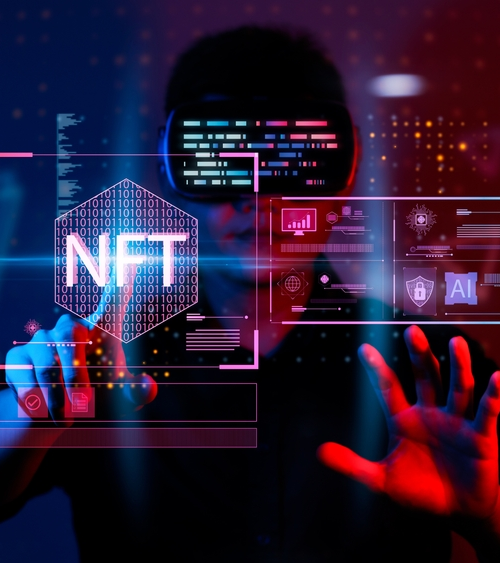Stephanie Hirschmiller Contributor | Forbes.Com
Troy Warren for CNT #NFT
Decentraland’s Metaverse Fashion Week (MVFW) offered one key element absent from its physical counterparts. Beyond the digital shows and virtual parties taking place March 24 – 27, the event featured prominent official exposure for retail — purpose built pop-up stores from luxury stalwarts like Selfridges, Tommy Hilfiger, Etro, Dolce & Gabbana and Dundas World.
Set for the most part in temporary shopping malls, these offered a combination of NFT wearables to wardrobe one’s avatar in Metaverse Decentraland (DCL) and limited edition physical pieces redeemable via NFTs — both purchasable only in cryptocurrency. The draw of the latter being that DCL was the only place to get them.
Said stores also served as a showcase for physical collections with click throughs to brands’ regular e-commerce sites.

Users were directed to DCL’s marketplace to purchase the DCL specific wearables which their avatars could actually try on to see how they look — both static and on the move — which is a nice touch.
Enabling technology created by fintech outfit Boston Protocol meant NFT ‘receipts’ for the physical pieces were available direct from the stores of participating brands like Hilfiger and Hogan.
While many retailers took advantage of the temporary spaces offered free of charge for the duration of Metaverse Fashion Week, Philipp Plein chose to purchase ‘real estate’ for a more long term set up.

He bought $1.4 million worth of land in DCL to build an 120 foot tall skyscraper and ‘Plein Plaza’ where he’s already opened a gallery dubbed the Museum of NFT Arts (M.O.N.A). He staged a show on the property over MVFW, presenting a Metaverse only collection of seven digital outfits for avatars to rock in DCL. Among them was a matching puffer coat and bucket hat combo emblazoned in a print featuring the ‘Lil Monsters characters he created with artist Antoni Tudisco.
While there’s often talk of cryptocurrency posing a barrier to sales — Selfridges and fellow British designer Roksanda Ilincic have previously chosen to sell NFTs in sterling — Plein sees it as a bonus. As of last year, he’s given buyers of physical goods the option to pay in crypto — both in store and online. “It’s been a huge success,” he said, “we take $100,000 worth of crypto payments every day.”

Tod’s Group owned Hogan launched a collection of NFTs in partnership with luxury NFT marketplace Exclusible. Via aforementioned Boston Protocol tech, they are redeemable for physical sneakers done in collaboration with artists from the digital Braw Haus creative studio. When the MVFW curtain falls, the Hogan store will remain in DCL for six months.
Nicholas Kirkwood offered DCL specific digital boots done in partnership with Metaverse community character White Rabbit. Next step will be collectable NFT artworks featuring booted incarnations of said bunny. For the cobbler who has long been obsessed with both technology and animation, “it’s a natural fit, almost like coming home.”

“It’s very exciting from a creative angle as you’re not limited by gravity and can make materials do really magical things,” he says. “It also opens up the brand to a whole new audience via the NFT community.”
Buzzy upcycled fashion label Imitation of Christ collaborated with ultimate NFT success story, Bored Ape Yacht Club on sweater dresses featuring Metaverse’s most famous monkeys. They also factored political statement into their in-store visual marketing via a ‘no war’ installation and banners expressing support for Ukraine.

French e-commerce accessories platform Monnier Paris (previously Monnier Frères) was another early adopter of Web 3.0, selling digital wearables created by digital native clothing outfit Republiqe on its own website as of last year. It launched a cryptocurrency payment option last week.
For the DCL store, Republiqu founder James Gaubert created limited edition wearables of labels carried by Monnier like Coach, Wandler and Ester Manas. For instance users can purchase the new Coach Tabby Pillow bag for their avatars to tote or click through from the virtual store to the Monnier Paris website and buy the real thing.
Gaubert is bullish about the possibilities of web 3.0 for retail. “It’s the most exciting thing for fashion since the Singer sewing machine he quipped at Monnier’s IRL MVFW launch party in Paris.

DCL Foundation creative director Sam Hamilton agrees. Going forward, he says, “there will be Metaverses where you can try on clothes with your own face and body shape (as opposed to that of your avatar as in the DCL Marketplace) so you can really see see how they look on you before you buy them.
For the record, at least one of the big luxury groups is currently building its own proprietary Metaverse.
Dundas World used its pop-up store and the fashion show that will close MVFW Monday 2 a.m. EST as vehicles to present a 12 look IRL collection you could click through to its e-commerce website to buy. Visual merchandising was bang on and featured the brand’s signature panthers wearing diamond collars.
Next step will be virtual versions made by digital native fashion outfit DressX. The two brands previously collaborated on wearables of looks Dundas made for Mary J. Blige’s Super Bowl performance in January. Look out for the next installment at next week’s Grammy Awards.

Another celebrity friendly designer who took part was Giuseppe Zanotti. While he didn’t have his own store, he teamed up with NFT collective DeadFellaz and fashion marketplace Neuno on a run of 1,000 digital wearables of his signature Cobra sneaker done in a zingy green colorway.

Estée Lauder was the only beauty brand to participate. To promote its famous Night Serum, it had creative director Alex Box design a free radiance aura which avatars could order from Estée’s MVFW activation space via a giant dropper based on the IRL bottle. Essentially it just involved the sort of sparkle filter you might get on Instagram but was still a novel way for beauty to join the conversation.
As for Selfridges, its undulating DCL edifice based on its physical Birmingham store didn’t sell anything at all. It opted instead for an exhibition of 12 NFT dresses with Paco Rabanne inspired by Op Art movement pioneer, Victor Vasarely. This mirrors a real life exhibition at Selfridges London. The British based retailer has long occupied the vanguard of experiential retail within the physical space so it made sense that the virtual equivalent followed suit.
According to Selfridges creative director Sebastian Manes, it is through such experimentation that the retailer continues to innovate. “This is how we test and learn and decide in the long-term what works for our brand and our customers,” he said, adding that he is currently evaluating new applications for Web 3.0 blockchain technology.
A particular area of interest is within ReSelfridges, the brand’s luxury resale arm as ledger based technology offers a means of authenticating provenance.

Just like the early days of the internet and e-commerce, Web 3.0 still has some way to go in terms of user experience which is far from seamless. However, as the brand representatives interviewed here all testify, the opportunities are immense and this is one big retail experiment from which they are confident they will profit in the longterm. *WAGMI.


































